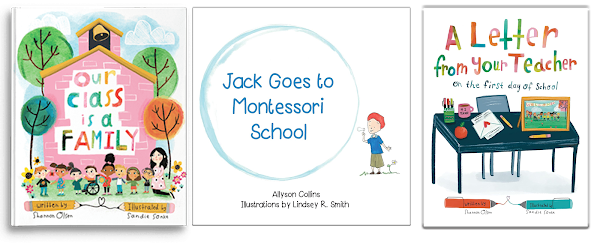Whether you teach in a Montessori early childhood or elementary environment, the focus of the first day is the same. It is about welcoming children to the prepared environment, getting to know each other, and setting a positive tone for the year ahead. Here are some ideas to inspire and support you as you embark on another year of guiding young minds.
The Discovery of the Child, p. 32.
Welcoming Song
Begin the first day by gathering together to sing a simple song that creates a warm, inclusive atmosphere. “This Pretty Planet” by Tom Chapin. is a favorite song for all Montessori levels. Young children enjoy adding simple hand gestures to the song, while elementary children love to sing it as a round.Watch “This Pretty Planet” on YouTube
Storytime
Reading a book together about the first day of school helps children express and manage any feelings they’re having about coming to school. Here are three current favorites:
- Our Class Is a Family
- Jack Goes to Montessori School
- A Letter from Your Teacher: On the First Day of School (The Classroom Community Collection)
Community Building Activities
Simple, cooperative games are a fun way for children to get to know each other and build community. Here are some ideas of non-competitive icebreaker games that involve movement and cooperation:
- Name and Movement Game: In this call-and-response game, each child takes a turn at saying their name while doing a movement. The group repeats the child’s name and copies the movement.
- The Yes/No/Stand Up Game: Children respond to questions (e.g., “Do you have a pet?”) by standing up if the answer is “yes” and sitting if the answer is “no.”
- Hula-hoop Pass: Children stand in a circle, holding hands. They work together to pass a hula-hoop from one to another, over their arms and heads, while still holding hands.
- Paired Scavenger Hunt: Younger or new students are paired with an older peer to find clues and materials around the Montessori environment.
Introduce Everyday Grace and Courtesy Lessons
Teach and model basic grace and courtesy, such as greeting one another, using quiet indoor voices, walking in the classroom, and gathering to go outside. Invite returning second- and third-year students to role-play these scenarios.
Classroom Tour
Take the children on a tour of the classroom, briefly introducing key areas of the classroom. Be sure to include important places such as the bathrooms, the Peace Corner, entries and exits for recess and dismissal, the snack area, the wastepaper basket, and even the box of tissues.This can also be a good time to remind returning elementary students how to get a work mat and create a workspace. Demonstrate how to choose, carry, and unroll the mat. Take a material off a shelf, carry it and place it on the mat. Then, show them how to carefully return the material to the shelf, running a finger along the front of the shelf to make sure the material lines up flush with the shelf. Return to the mat, roll it up, and carry it back to its place. (Children in the early childhood environment and students new to the elementary environment will learn these routines soon as well, during formal presentations.)
Enjoy a Group Snack
Sharing a group snack is a wonderful way to build community and help children feel comfortable in their new environment. Having a snack together fosters a sense of belonging and encourages social interaction, making it easier for children to form connections with their peers. It also provides an opportunity to practice grace and courtesy in a relaxed setting.
Review Routines and Establish Class Rules
Discussing the daily classroom schedule can help reduce any anxiety the children may have about school. Children feel more comfortable and safer when they know what to expect and what is expected of them.© North American Montessori Center - originally posted in its entirety at Montessori Teacher Training on Tuesday, August 27, 2024.






0 comments:
Post a Comment
Have questions or comments? Let us know what you thought about this article!
We appreciate feedback and love to discuss with our readers further.